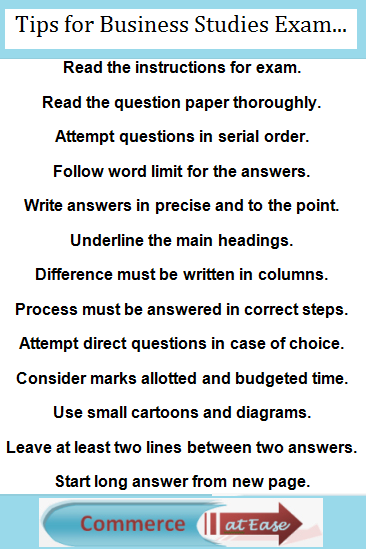13 Tips to Attempt Business Studies Exam.
Here are the basic guidelines for attempting Paper in Business Studies:
1. During the first fifteen minutes given specially for this purpose, Read the question paper thoroughly, to understand what is required to be written. You can also plan the strategy of answering the questions as to which questions are to be answered first and which to be attempted later on.
2. Read the instructions properly, regarding the parts, word limit for the answers etc.
3. Try to attempt the questions in serial order. Space can be reserved for the answers to be written later on.
4. Word limit for the answers to different questions must be adhered to. Rather than counting the words in the answer make a rough estimate of your words in a line and then count the number of lines to be used.
5. Answers must be precise and to the point. Write what is relevant to the question. Don't try to impress the examiner by writing the material not asked in the question directly or indirectly.
6. In case of long answers you must underline the main headings or write the main headings in CAPITAL LETTERS with dark blue ink. Colour ink other than blue is strictly prohibited in the examination.
7. Answer to questions involving difference must be written in columns. Usually, the first column should be used for writing the basis of difference and in the second and third columns you may write the explanation of that basis with respect to the concepts which are to be distinguished.
8. Questions involving process must be answered in steps in serial order. If that sequence is broken you should not expect marks for the answer. Must give a diagram clearly labelled, showing the process. The process is depicted in the form of a flow chart.
9. In case of internal choice in the questions, try to attempt direct questions, to get maximum marks. In such questions the variation between the answer written and the answer expected by the examiner is minimum.
10. While starting to write the answer to the question, once again read the question thoroughly to decide the answer required by the examiner.
11. Answers must be written as per the marks allotted and the budgeted time.
12. You can use small cartoons and diagrams or mind maps to support your answers.
13. While answering the questions involving case studies, give the answers with reference to the topic in question. Don't write the general answer.
14. Wherever possible give example in your answer.
Above all, you must make it sure to follow the Golden Principle "Make the examiner happy by writing what he wants, he will make you happy by giving the marks that you want".

